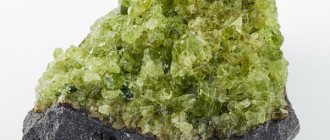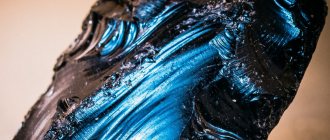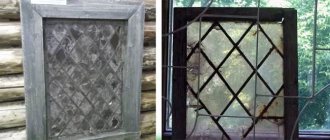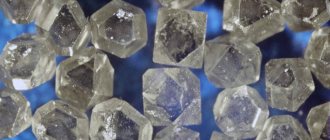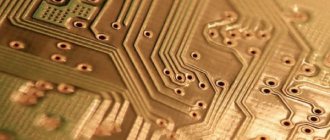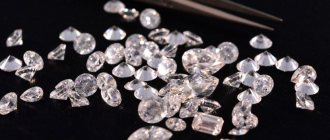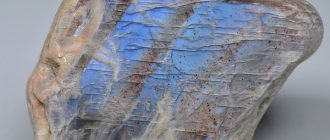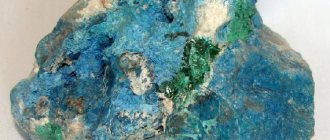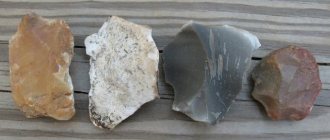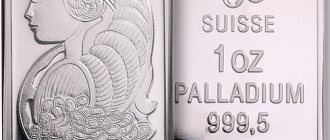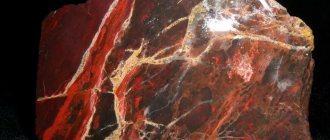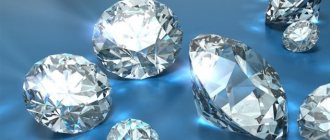origin of name
The ancient Italian name of the city of Moscow is Musca. A transparent variety of the mineral, which was used instead of window glass, large sheets of muscovite, exported to the west through Moscow from “Muscovy”, were called Moscow glass.
Content
Muscovite cirrus (Mongolia)
- Chemical composition
- Varieties
- Crystallographic characteristics
- Form of being in nature
- Physical properties
- Chemical properties
- Diagnostic signs
- Origin of the mineral
- Place of Birth
- Practical use
- Physical research methods
- Crystal optical properties in thin preparations (sections)
- Buy muscovite
Medicinal properties
Doctors have identified the positive effects of these crystals on the human endocrine system. If you have pathologies of the thyroid gland or unstable levels of essential hormones, it is recommended to purchase a bracelet containing this mineral.
If you consume muscovite powder, you will be able to defeat infectious diseases, significantly strengthening weakened immunity.
Chemical composition
Theoretical composition: potassium oxide (K2O) 11.8%, aluminum (Al2O3) 38.5%, silicon dioxide (SiO2) 45.2%, water (H2O) 4.5%.
Muscovite rich in Fe2O3 is called ferrimuscovite . Minor changes in the chemical composition give rise to a distinct zoning of muscovite crystals. There is no isomorphism between muscovite and biotite (or other trioctahedral mica), but due to the similarity of their structures, both minerals often intergrow with each other.
Varieties
- Sericite - Dense, fine-flaky light muscovite with a silky sheen. "serikos" in Greek is silky, possibly with a higher silica content, in which case it may be transitional to phengite K(Fe, Mg)Al[(Al,Si)Si3O10](OH, F)2. Chromium-containing phengite is called mariposite , and phengite with some Mn2+ and Mn3+ is called alurgite .
- Fuxite is a fine-flaky bright green (chromium-containing) muscovite. Cr2O3 up to 4.8%;
- Ellacherite - barium muscovite (K, Ba)(Al, Mg)2 [AlSi3O10](OH, F)2 With BaO up to 10%.
- Roscoelite is essentially vanadium muscovite with a V2O3 content of about 28%.
- Damurite is a partially hydrated muscovite or sericite, transitional to hydromicas.
- Gilbertite is a light yellow, fine-flaky muscovite of pegmatites and ore veins.
Muscovite cost
Most often, such stone is sold at a negotiated price. Manufacturers do not specifically include the cost for the product, since it will depend on the quantity of stone ordered and the distance from which it is delivered to the buyer.
This applies to both powder and cut pieces of the mineral. The latter includes plates and cut out parts of mica masses. There is even a special condenser nutmeg. But the price is necessarily indicated on collection samples of muscovite. The maximum price will be set for prismatic mica crystals. Unlike leaf plates, they are considered especially rare. Also, any collector would like to purchase a druse made of prismatic crystals.
The cost for such a mineral reaches 4,300 rubles. The height of the mass of such a mineral reaches six centimeters. The total width is five centimeters. The cost of mica increases due to imports. For example, muscovite may have been imported from Nepal.
Sources
- https://TokyoStreet.ru/podelochnye-kamni/slyuda-kamen-opisanie.html
- https://MoyKamen.com/vidy/prochie/muskovit-mineral.html
- https://natural-museum.ru/mineral/%D0%BC%D1%83%D1%81%D0%BA%D0%BE%D0%B2%D0%B8%D1%82
- https://kristallov.net/muskovit.html
- https://aano.ru/hiromantiya/muskovit-mineral.html
- https://mir-magnitov63.ru/kamni/slyuda-mineral.html
- https://astroson.com/svoystva-kamney/muskovit-magicheskie-svoystva-kamnya/
- https://vplate.ru/kamni-i-mineraly/muskovit/
- https://vseprokamni.ru/vidy/drugie/kak-vyglyadit-slyuda.html
- https://natrukodel.ru/prochie/muskovit
- https://kamniexpert.ru/gems/muskovit.html
- https://kamneteka.com/kamen-muskovit-svoystva/
- https://zakamnem.ru/vidy/muskovit-mineral
- https://zakamnem.ru/vidy/slyuda-eto
Crystallographic characteristics
M., lamellar aggregates with quartz and biotite (Inkutsk region)
Monoclinic syngony .
Symmetry class. Monoclinic-prismatic c. With. L2PC. Space group C2/c (C62h). a0 = 5.18; b0 = 9.02; c0 = 20.04; β = 95°30′. Axle ratio. 0.574 : 1 :2.221; (3 = 95°30′. The data refer to the most common polytype of dioctahedral micas 2M1. - 2/t s., p = 95c30, Z = 4, but muscovites of the lMd, 1M and ZT types are also known.
Crystal structure
Layered lattice.
Main forms : Pseudohexagonal muscovite crystals with forms c{001}, b{010}, m{110}, e{023}, y{043} and x{131} are common.
Application of the mineral
Since muscovite is one of the most reliable and long-lasting dielectrics, it is widely used in many construction works and in manufacturing, especially those related to electronics.
This popularity of the stone is due to the fact that it is characterized by high electrical insulation and resistance to high temperatures. Such mineral rock is responsible for an important function - it does not allow current to pass through. It is for this reason that muscovite is widely used in the production of electronic equipment and energy devices.
Areas of application of muscovite:
fracture muscovite continues to be actively used in the creation of glass products - windows (for stoves and cars most often);- very often the stone, or rather, the powder from it, becomes part of roofing felt, lubricants, roofing, point stones, paints with a high fire resistance and various enamels;
- In addition, muscovite is also added when creating items such as cardboard, paper and wallpaper;
- Car manufacturers have also noted the beneficial properties of this mineral. Now such stone has become very often added when creating tires for vehicles. They differ in that they are not so subject to overheating, which usually occurs during regular friction;
- despite the fact that such a mineral is very rarely used in jewelry, since it is not at all precious, some craftsmen who create jewelry in their companies widely use such a mineral when creating costume jewelry to order from clients;
- the mineral is actively used in the creation of capacitors, smartphones and insulators.
There are quite a few areas of use for this mineral rock, which makes it especially popular.
Use in Ancient Rus'
In the 17th century, muscovite was most often mined in the country; it was for this reason that the mineral was called “Moscow star” or “Moscow glass”; in the mid-nineteenth century it was renamed muscovite. Such rock-forming stone is included in the composition of metamorphic, igneous and sedimentary minerals. Like other micas, muscovite, due to its crystalline structure, quickly splits into transparent plates. It is not particularly protected from the weathering process and quickly changes to the state of clay. It also does not decompose when exposed to acids.
Form of being in nature
The appearance of crystals . Regular tabular or lamellar, pseudohexagonal or diamond-shaped. Sometimes individuals with a columnar-pyramidal appearance are observed. The lateral edges are usually heavily streaked in horizontal directions.
Twins are common according to the mica law, rare according to the chlorite law.
Aggregates. Muscovite can also occur in continuous leafy-granular or scaly masses. Occasionally there are clusters of spherulites and kidney-shaped masses with concentric shell-like individuality. Solid, dense, hidden-scale masses with a silky sheen, sometimes difficult to recognize even under a microscope, are called sericite.
Varieties of muscovite
Muscovite mineral photo
Muscovite crystals have many names:
- cat silver;
- potassium mica;
- Moscow star;
- butcheporitis;
- Shernikit.
According to variety, muscovite is divided into:
- alurgite - contains a significant amount of Mn;
- fuchsite - rich green color, contains Cr, is quite rare in nature;
- phengite is a material with a high Si content;
- sericite - a material with thin granular plates with an insignificant K2O content;
- mariposite - contains a significant amount of Cr.
Physical properties of muscovite
Muscovite, crystal in pegmatite (Ilmensky)
Optical
- Color. In thin commissural leaves, colorless, silvery-white, gray, white, light yellow, light brown, greenish to brownish, often zonal. Rarely reddish tint. Fuchsite is bright green.
- Trait. White.
- Glass shine.
- The sheen on the cleavage planes is pearlescent, the dense scaly masses have a silky sheen, silvery.
- Transparency. Transparent, translucent.
The refractive indices are Ng = 1.588–1.615, Nm = 1.582–1.611 and Np = 1.552–1.572.
Mechanical
- Hardness. 2-3, elastic. The leaves of muscovite, like all minerals of the mica group, are flexible and elastic when bent; varieties are known that are transitional to brittle micas and, conversely, close to talc-like.
- Density 2.76-3.10 increases with increasing iron content (for roscoelite - 2.97).
- Cleavage is very perfect along {001}, imperfect along {110} and {010}, which are slip planes
- The fracture is stepped or uneven. The mineral is flexible and splits into leaves.
Chemical properties
Behavior in acids. It does not dissolve; at temperatures above 850 °C, water loss occurs.
Other properties . Individual leaves are flexible and elastic. Muscovite is an excellent insulator for electric currents of ordinary voltage and has a fairly high breakdown resistance.
Diagnostic signs
Muscovite transparent crystals
Similar minerals. Paragonite (sodium-aluminum mica, or sodium muscovite), phlogopite, biotite, talc, Maryino glass (transparent spar-like gypsum).
It is easily recognized by its external characteristics: light color, pearlescent or silvery sheen, very perfect cleavage and easy splitting into thin transparent elastic leaves. It differs from phlogopite in optical constants, mainly in the angle of the optical axes (in phlogopite it is very small).
It is similar to talc, but is not greasy to the touch and its scales (leaves) are flexible and elastic.
Associated minerals. Quartz, feldspars (orthoclase, oligoclase), calcite, apatite, biotite, hornblende, garnet (almandine), staurolite, kyanite, chloritoid, tourmaline, etc.
Magic properties
Actively affecting all possible spheres of human life, the energy of muscovite fluctuates significantly, it depends on the color scheme of the crystal. A yellow or brown mineral is often used as a talisman that can attract material benefits and good luck in life to the owner.
White as well as gray samples are an ideal amulet for travelers, especially if they want to explore the world while traveling in winter. Pink crystals are recommended for people planning to create a truly strong family. Their energy has a strong impact on strengthening love and maintaining fidelity in relationships.
For those who dream of becoming decisive and confident, it is better to choose green-colored crystals. Regardless of the range of colors, muscovite is an amazing mineral because it saves the owner from any unpleasant situations, prevents injuries, and prevents negative messages sent by evil people.
Origin and location
A common, chemically stable mineral.
Among the minerals of the mica group, it is widely distributed. As a rock-forming mineral, it is included in the composition of some intrusive rocks , in particular, in the composition of granites, especially greisen, i.e., pneumatolytically altered varieties of them, in association with topaz, lithium mica, quartz, sometimes wolframite, cassiterite, molybdenite, etc. In these cases, muscovite is formed mainly due to previously released potassium feldspars (orthoclase and microcline).
Relatively often found in granite pegmatite veins in the form of large crystals of industrial interest. Muscovite in such veins, especially in the central parts, often produces clusters in the form of nests up to 1–2 m in diameter, but is usually randomly scattered in the form of large crystals throughout the entire mass of pegmatite or along certain zones.
Zircon, rutile in the form of a saguenite lattice, apatite, spinel, garnets, tourmaline, quartz, magnetite, etc. are sometimes found as tiny inclusions in muscovite crystals. With a detailed study, in some cases, it is possible to establish certain patterns of orientation of these inclusions in accordance with the structural features of the minerals.
in contact-metasomatic deposits. There are known cases of the formation of fine-grained muscovite in sandstones at their contact with granites and other acidic igneous rocks.
Under hydrothermal conditions, sericite is usually formed due to the decomposition of spars (sericitization, i.e. the formation of sericite - a cryptocrystalline variety of mica enriched in water): 6KAlSi3O8 + 4H2O + CO2 + ZAl2O3 -> 4KAl2[AlSi3Oi0](OH)2 + K2CO3 + 6SiO2. Sericite is stable in neutral (weakly acidic or slightly alkaline) solutions at relatively high temperatures, while in more acidic solutions pyrophyllite and kaolinite are formed instead; the latter is a lower temperature mineral.
In metamorphic rocks, muscovite and sericite are widespread. Entire massifs of mica crystalline schists, sericite-containing shales (phyllites) and quartzites with muscovite are known. In such rocks, feldspars are usually absent, because being the initial source for the formation of muscovite micas under conditions of regional metamorphism.
During weathering processes it is relatively chemically resistant and often turns into placers. Due to its ability to easily split into small leaves and due to its low specific gravity, it usually accumulates in the form of tiny silvery sparkles in silty sediments and layered clays formed in water basins with slow water movement.
Under conditions of intense chemical weathering, muscovite is capable of transforming into hydromicas richer in water - hydromuscovite, and when passing into an alkali solution - into kaolinite.
History of the stone and description
The unique characteristics of the mineral became known several centuries ago. It was used as glass, giving the mineral the shape of plates. Russia was the only supplier of muscovite, selling it to European countries. Since our country was then called Muscovy, the Swedish scientist proposed calling the crystals Muscovite. Nugget glass windows were very expensive and were installed only by rich people. Large plates were sent only for export, but small sheets, fastened with small nails, after decoration, well imitated stained glass designs in Russian houses.
Muscovite is immediately distinguished by its silvery tint and light tone. The mineral breaks down well, forming thin plates. In the natural environment, a crystal is part of rocks. Among the inclusions there are pockets of garnet, zircon, quartz or spinel. When weathered, a nugget can transform into a small placer. Due to its low specific gravity, the mineral breaks down easily, forming silvery sparkles that accumulate in water if it moves slowly.
Place of Birth
Of the numerous mineral deposits, we will indicate only the most interesting, widespread in pegmatites.
In the north-west of the European part of Russia there was an ancient mica trade. Deposits in Karelia were known back in the 15th century. Mica-bearing pegmatite deposits are located among granites, gneisses, mica schists and other metamorphic rocks. Muscovite is associated with feldspars, quartz, and to a lesser extent with schorl, apatite and other minerals.
Mica deposits are common in the Mamsky region of Eastern Siberia. A wide mica-bearing strip of metamorphic schists is bounded by granite massifs in the northwest and southeast. Crystals of muscovite (sometimes up to 50 cm) with a reddish or yellow-greenish tint are observed in paragenesis with acidic plagioclase, microcline, quartz, biotite, in some cases with black tourmaline, apatite, garnet, etc. Mica is completely transparent, easily splits into thin sheets with a smooth surface. smooth surface.
The main foreign deposits of muscovite in pegmatites are located in India (Bengal and Madras regions), where muscovite crystals up to 3–5 m2 or more are found; in a number of US states (North Carolina, Maryland, etc.); in Brazil, Canada, East Africa; Australia; Norway and other deposits.
In Germany, M. is widespread in the Ore Mountains (Fichtel Mountains), in the Saxon Granulite Mountains (schist cover), in the area between Hohenstein-Ernstthal and Karl-Marx-Stadt (Langenberg Heights), along the western edge of the Thuringian Forest near Rula, between Riesa and Meissen, Nosean, Siebenlen and other places. Here, fine-scaled muscovite (sericite) is associated with phyllites.
Muscovite subgroup
These include aluminum micas, mainly muscovite, which is widespread in nature, and rare paragonite. Compared to the minerals of the biotite group, here 3(Mg,Fe)2+ is replaced by 2Al3+, i.e., similar to what we saw in the talc-pyrophyllite group.
Muscovite
— KAl2 [AlSi3O10] [OH]2, or K2O•ZAl2O3•6SiO2•2H2O. The name comes from the ancient Italian name of the city of Moscow - Musca. At one time, large sheets of muscovite were exported through Moscow to the west under the name “Moscow glass”.
Chemical composition
(in%): K2O 11.8, Al2O3 38.5, SiO2 45.2, H2O 4.5.
Bright green chromium-containing mica (Cr2O3 up to several percent) is called fuchsite
.
singonia
monoclinic;
monoclinic-prismatic c. With. (For the crystal lattice, see Fig. 334-A). The appearance of the crystals
is usually tabular or lamellar, pseudohexagonal or rhomboid in cross-section.
Sometimes individuals with a columnar-pyramidal appearance are observed. The lateral edges are usually heavily streaked in horizontal directions. Twins are common according to the mica law (Fig. 329), rare according to the chlorite law. Aggregates
.
Muscovite can also occur in continuous leafy-granular or scaly masses. Occasionally, kidney-shaped masses with concentric shell-like separation are found. Hidden scaly masses with a silky sheen, sometimes difficult to recognize even under a microscope, are called sericite
.
Color
.
in thin commissural leaves it is colorless, but often with a yellowish, grayish, greenish and rarely reddish tint. Fuchsite is bright green. The luster
is glassy, pearlescent and silvery on the cleavage planes. Ng=l.588-1.615, Nm = l.582-1.611 and Np = 1.552-1.572.
Hardness
2-3.
The leaves of muscovite, like all minerals of the mica group, are flexible and elastic when bent; varieties are known that are transitional to brittle micas and, conversely, close to talc-like. The cleavage
is very perfect along {001}, imperfect along {110} and {010}, which are slip planes.
Ud.
weight 2.76-3.10.
Other properties
. Muscovite is an excellent insulator for electric currents of ordinary voltage and has a fairly high breakdown resistance.
Diagnostic signs
. Muscovite is easily recognized by its external characteristics: light color, pearlescent or silvery luster, very perfect cleavage and easy splitting into thin transparent elastic leaves. It differs from phlogopite in optical constants, mainly in the angle of the optical axes (in phlogopite it is very small).
P. p. tr. thin plates melt with difficulty into opaque white enamel. Does not decompose with acids. Water begins to be released only at a red-hot temperature (above 850°).
Origin
.
Muscovite is widely distributed among the minerals of the mica group. As a rock-forming mineral, it is included in the composition of some intrusive
rocks, in particular in the composition of granites, especially
greisen
, i.e., pneumatolytically altered varieties of them, in association with topaz, lithium mica, quartz, sometimes wolframite, cassiterite, molybdenite, etc. In these cases, muscovite is formed mainly due to previously released potassium feldspars (orthoclase and microcline).
Relatively often, muscovite is found in granite pegmatite rocks
veins in the form of large crystals of industrial interest. Muscovite in such veins, especially in the central parts, often produces clusters in the form of nests up to 1-2 m in diameter, but is usually randomly scattered in the form of large crystals throughout the entire mass of pegmatite or along certain zones.
Zircon, rutile in the form of a saguenite lattice, apatite, spinel, garnets, tourmaline, quartz, magnetite, etc. are sometimes found as tiny inclusions in muscovite crystals. With a detailed study, in some cases, it is possible to establish certain patterns of orientation of these inclusions in accordance with the structural features of the minerals.
Muscovite is rare in contact-metasomatic deposits. There are known cases of the formation of fine-grained muscovite in sandstones at their contact with granites and other acidic igneous rocks.
In hydrothermal
In ore deposits and hydrothermally altered rocks, sericitization processes are extremely widely developed, i.e., the formation of sericite, a cryptocrystalline variety of mica enriched in water.
In metamorphic
In rocks, muscovite and sericite are widely used. Entire massifs of mica crystalline schists, sericite-containing shales (phyllites) and quartzites with muscovite are known. In such rocks, feldspars are usually absent.
During weathering processes, muscovite is relatively chemically resistant and often turns into placers. Due to its ability to easily split into small leaves and due to its low specific gravity, it usually accumulates in the form of tiny silvery sparkles in silty sediments and layered clays formed in water basins with slow water movement.
Under conditions of intense chemical weathering, muscovite is capable of transforming into hydromicas, hydromuscovites, which are richer in water, and when passing into an alkali solution, into kaolinite.
Practical significance
. The most important practical property of muscovite, as well as phlogopite, is its high electrical insulating qualities. In industry, mica is used in the form of mica sheets, mica powder and various mica products.
The most valuable sheet mica
is used mainly in the electrical industry: for insulators, capacitors, rheostats, telephones, magnetos, electric lamps, kerosene stoves, mica glasses and other purposes. Depending on the size of the plates, the degree of their transparency and uniformity of color, several varieties of sheet mica are distinguished.
Mica powder
(scrap), obtained by grinding waste from cutting mica sheets, is used in the manufacture of fire-resistant building materials (roofing felt), wallpaper, writing paper, mica cardboard, fire-resistant paints, brocade paints, various ceramic products, car tires, for explosives (in as an adsorbent), lubricants, etc.
Mica factories
, mainly micanite, are used as substitutes for sheet mica in cases of less critical use (for electrical insulating gaskets in some electrical appliances: electric kettles, saucepans, irons, etc.). Micanite is made from small mica leaves and scraps obtained in the form of residues when using sheet grade mica, by gluing them with shellac and subsequent pressing under high pressure.
Place of Birth
. We will only indicate the most interesting muscovite deposits in pegmatites.
In the north-west of the European part of the USSR there was an ancient mica trade. The deposits were known back in the 15th century. Mica-bearing pegmatite deposits are located among granites, gneisses, mica schists and other metamorphic rocks. Muscovite is associated with feldspars, quartz, and to a lesser extent with tourmaline, apatite and other minerals.
Mica deposits are common in Mamsky
region of Eastern Siberia. A wide mica-bearing strip of metamorphic schists is bounded by granite massifs in the northwest and southeast. Crystals of muscovite (sometimes up to 50 cm) with a reddish or yellow-greenish tint are observed in paragenesis with acidic plagioclase, microcline, quartz, biotite, in some cases with black tourmaline, apatite, garnet, etc. Mica is completely transparent, easily splits into thin sheets with a flat, smooth surface.
The main foreign deposits of muscovite in pegmatites are located in India
(Bengal and Madras regions), where muscovite crystals up to 3-5 m2 or more are found;
in a number of US states (N. Carolina, Maryland, etc.); in Brazil, Canada
and other countries.
Practical use
About 90% of muscovite is used as a dielectric in the electrical industry, radio engineering and instrument making. Mica powder (scrap) - for the production of fire-resistant building materials, wallpaper, paper, paints, etc.
The most important practical property of muscovite, as well as phlogopite, is its high electrical insulating qualities. In industry, mica is used in the form of mica sheets, mica powder and various mica products.
The most valuable sheet mica is used mainly in the electrical industry: for insulators, capacitors, rheostats, telephones, magnetos, electric lamps, kerosene stoves, mica glasses and other purposes. Depending on the size of the plates, the degree of their transparency and uniformity of color, several varieties of sheet mica are distinguished.
Mica powder (scrap), obtained by grinding waste from cutting mica sheets, is used in the manufacture of fire-resistant materials (roofing felt), wallpaper, writing paper, mica cardboard, fire-resistant paints, brocade paints, various ceramic products, car tires, for explosives ( as an adsorbent), lubricants, as thermal insulation in steam boilers, etc.
Mica fabricates, mainly micanite, are used as substitutes for mica sheets in cases of less critical applications (for electrical insulating gaskets in some electrical appliances: electric kettles, saucepans, irons, etc.). Micanite is made from small mica leaves and scraps obtained in the form of residues when using sheet grade mica, by gluing them with shellac and subsequent pressing under high pressure.
Areas of use
Muscovite is an excellent insulator. It does not pass electric current at normal voltage and has a high resistance before breakdown. Crystals are used as a reliable dielectric for electrical engineering; powder from the mineral is used in the manufacture of building materials and paper with electrical insulating properties.
Mica is used in the production of power plants, in computers and transistor receivers, and is indispensable in the manufacture of electrical switches. The material is used in woodworking production. Metallurgists and chemists make stove windows and car windows from it.
The smallest mica crystals are used to produce soft roofing materials, all kinds of lubricants, paper or wallpaper; they are added as a component for fire-resistant paints, tires for vehicles, and grindstones. After gluing and pressing such chips, micanite is obtained - a material that can qualitatively replace ordinary sheet mica.
Physical research methods
Differential thermal analysis . The DTA curve of muscovite shows three endothermic peaks at temperatures around 125, 860 and 1180° and one exothermic at 377°; the latter is caused by the oxidation of divalent iron.
Main lines on X-ray diffraction patterns : 10.04(10) - 5.02(5) - 4.48(6) - 4.46(5) - 3.35(10) - 2.56(8) (muscovite 2M1) ; 10.08(10) - 4.49(8) - 3.36(10) - 3.07(5) - 2.58(5) - 2.56(8) (muscovite 1M); 9.99(10) - 4.99(8) - 3.33(10) - 2.56(5) (muscovite 3T).
Ancient methods. It melts with difficulty under a blowpipe; in this case, a gray or yellow glass pearl is formed - white enamel. Water begins to be released only at a red-hot temperature (above 850 °C).
Interference coloring in thin section
Crystal optical properties in thin preparations (sections)
Muscovite is colorless. Fuchsite is green, roscoelite is dark green to dark brownish with distinct pleochroism and normal absorption: Ng > Nm > Np. ng = 1.588 4- 1.624, nm = 1.582 - 1.619, np = 1.552 - 1.570, higher for roscoelite (ng = 1.704, nm = 1.685, np = 1.615). (—)2V = 35 H - 50°, phengite has less (10 - 25°); mariposite and alurgite are almost uniaxial. The plane of the optical axes is perpendicular to (010), Np is almost J_ (001), but for three-layer mica with c0 = 30.40 A and p ~ 90° (C2 symmetry), the plane of the optical axes is parallel to (010), (—)2V = 15° .
Muscovite under a microscope in transmitted light
Muscovite deposits
Muscovite is mined in loose rock deposits, sedimentary rocks:
- arkozakhah;
- sandstones;
- clayey shales;
- greywackah.
The most famous mining sites are:
- Ural, Siberia;
- India, Madras state;
- USA, North Carolina;
- Australia;
- Canada;
- Norway;
- Germany, Fichtel mountains;
- Brazil;
- France.
